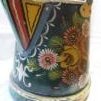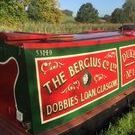

rjasmith
Patron-
Posts
1,106 -
Joined
-
Last visited
About rjasmith

- Birthday 09/06/1949
Profile Information
-
Gender
Male
-
Location
Wey and Arun Country
-
Occupation
Semi retired engineer
-
Boat Name
Shilla (just a shell at the mo!)
-
Boat Location
In the garden!
Recent Profile Visitors
9,229 profile views
rjasmith's Achievements
-
Good Lord - So can I now! Well done Rich and thanks from me too! Back in 2018 something made me want to look again at someone's photos I'd once seen in the Gallery. It must have been just after a forum upgrade or move to a different platform or whatever. Having found the gallery no longer worked for me I suppose I just gave up and forgot about it. I've now got no idea what it was I wanted to look for 5 years ago- can't have been that important but I'll have a rummage in there sometime now that I can! Richard
-
Oh good - It isn't just me then! Richard
-
No not really! I do have some nice doors - just painted white, boring perhaps but I like them. Richard
-
Thanks for the suggestion but clicking your link doesn't work either! Richard
-
Thanks for that! But I can't see anything in there! Not even those nice garage doors! I do feel deprived! Can you see anything else that might be vaguely interesting? I'm using a Win 10 PC whereas perhaps you're on a phone of some sort. Perhaps there's a forum setting I need to change? Richard
-
rjasmith started following Reflex stove vibrating noise and Gallery Menu
-
Back in 2018 I asked a question about why I can't see anything if I click on the Gallery menu! I started getting some help from @RichM who gave me a link to get to it but that didn't work for me either! Are there supposed to be any pictures in there, if so why can't I see them or if there aren't, what is the pulldown Gallery label there for? Still puzzled after all these years! Richard
-
Have you got a draught stabiliser flap on the flue just above the top of your Refleks? If you do, is it set up correctly? (Eg like one of these https://www.toplicht.de/en/cabin-comfort/stoves-heaters/exhaust-gas-regulatos-spares-accessories/refleks/4678/flue-gas-damper-refleks) Richard
-

Midi Link Fuses Versus Mega Link Fuses
rjasmith replied to alan_fincher's topic in Boat Building & Maintenance
Looks like 40A and 60A are available in the Mega fuse range and there are even suppliers on eBay! Richard -
Oh dear! This is not a good start to 2019! I've just spoken to MCL on the phone and they say it was for the usual reasons that other County Libraries have decided to shut off remote access via their websites to BSOL, ie BSI themselves adjusting their access licence rules rather than increasing the charges beyond the level where the library felt it was uneconomic. Apparently MCL are still in discussion over the changes so watch this space (but don't hold your breath). Meantime, try heading over to Glasgow Libraries perhaps. I've just found my way in via their website which currently still works! Richard
-
As you are "looking up the regulations" (ref your OP) why not have a go at using Manchester City Library's excellent website to read the definitive advice on boat stove installation from British Standards Code of Practice, BS 8511:2010. The "Soliftec" guide drawing everyone quotes is merely a precis of BS 8511 and is very helpful but doesn't give all the options by any means. The Boat Safety Scheme also extensively refers to BS 8511 as I'm sure you already know. I have endlessly explained on CWDF before how to access this doc using the library site and here's a link to an earlier post that does this as it's not completely obvious! The MCL site allows any UK resident to view BS docs for free and you do not have to be a library member. Using a metal shield is completely acceptable to BS 8511 and is Option B (para 7.3). Option A is the usual insulated board and Calcium Silicate is clearly the best. For Option B the type of metal is not specified so steel would be fine. The way the metal shield is fixed is vital and there must be an air gap at the bottom as well as the top to let convection air currents pass up behind the shield. Also the metal sheet must be fixed to the combustible wall behind using insulated stand offs. BS 8511 gives excellent sketches of how this can be done and specifies a whole range of acceptable gap dimensions etc. Richard
-
Thirded Richard
-
Best way to read Recreational Craft Directive related info is to use Manchester City Library's (MCL) free link to British Standards Online (BSOL) website (link here). Click on the "Go to British Standards Online" box. Once in BSOL, in their little search box (top right hand, in the grey bit) type in the number "13297" for the ISO standard that covers the RCD requirements for Boat AC electrical systems. A list of 5 results will come up. You want the top one which will give you the latest edition (2014) of BS EN ISO 13297. To read the document (you're not allowed to print or download it I'm afraid unless you want to buy it for £198!), click on the little icon to the far right of the title (looks like a little Adobe Acrobat logo, above the words "In your subscription"). After a short delay a read only .pdf version of the doc will open and you'll be able to read all of it for free (all paid for by MCL). Very few libraries in UK cover the cost of doing this now - thank you MCL! You can read copies of 13297 and some other RCD ISOs by just Googling but these are very often pirated copies of out of date issues. The 2014 issue of 13297 has very nice drawings of typical boat AC installations at the back, earlier issues don't have these. Richard
-
I have fairly successfully matched a replacement pressure sender to a gauge in an old Land Rover. The sender may either work with a diaphragm that changes a variable resistor wiper or, more commonly, it may mechanically change the mark/space ratio of a pulsing contact. The gauge I had used this second principle. The gauge sends a current (from 12v) into the sender which does two things. In the gauge, it heats a little element which causes the needle to move because it's attached to a bimetallic strip and in the sender it heats another element. The sender is arranged like a car indicator flash relay and starts "flashing" quietly thus pulsing the current on and off. Oil pressure moves a diaphragm in the sender which alters the flash contact position slightly and therefore changes the current's mark/space ratio. As oil pressure rises the current is more ON than OFF and the gauge needle moves further from zero to show this. The reverse happens for lower pressure. all very crude but simple! The pulsing is too fast for the slow response gauge so the needle doesn't "wobble" in time to the pulse. I didn't have a sender for the L/R because I'd lost the original in my garage (very silly)! However new ones working this way are available from eg here or try an eBay search for "Oil Pressure Sender Land Rover". Your BMC engine probably uses Smiths gauges which should be compatible with these senders. I did a bit of calibration on my set up using an air line and a known correct air pressure gauge. To get it spot on I found I needed a small shunt resistor of about 100 ohms across the oil gauge. The only other thing you'll need to get right is the pipe connection to the engine. I had to buy a thread size adaptor once I'd found what was needed. You may want to use a few other fittings anyway so that you can position the new sender out of the way of the filter. Richard
-
OK - here are the dimensions of my Premier in good old fashioned inches I'm afraid! Measured across top plate - 20" x 13" (No side extender plates fitted) Height bottom of base plate to top of top plate - 13" I have the legs on mine although they are for "show" only - I use a welded steel hidden "chassis" behind them to support it. The legs add a further 8 3/4" if you use them. However where will you find a Premier nowadays? I thought the foundry/assembly place on the IoM (linked to Midland Chandlers) had long ago stopped producing them. Richard edit to add - Of course you could go for one of those Bubble Back Cabin stoves which are also welded rather than cast but maybe they're a bit big and also have a rather big price! (I haven't got one and have no connection to Harworth Heating!) Link here
-
Splendid new Wheeze Bizz! But did you know these things are really with us and have been for the last 30 years or so? The JET Fusion experiment at Culham uses two fairly enormous flywheel generators to help smooth out the 300Mw pulses of power dragged out of the Nat Grid when they fire up the torus to create a hydrogen plasma. These things are spun up beforehand and help stabilise the Nat Grid to stop it all going horribly wobbly (technical term) while the pulse is on. Seems like a long time ago now but I was a bit involved with this stuff in 1984 when Nat Grid was still part of the CEGB! The motor/generators on the ends of the flywheel shafts are similar to the ones inside the Dinorwig pumped storage power station (300Mw each machine). Here's the best picture link I can find. Link Richard







